As a homeowner, we know choosing a new roof can be overwhelming. Today, there is more to consider, such as which roofing material is recyclable and which is the coolest for your home. There’s also a new kid on the block – stone-coated metal shingles.
In our residential roofing guide, we list the popular residential roofing materials available to you, show their life expectancy, the advantages and disadvantages of each, and more.

Table of Contents
- What are the different types of roof material?
- Which roof material type is best?
- What are asphalt shingles, modified bitumen?
- What’s a tile roof and a metal roof?
- The life expectancy of asphalt shingles, tiles, metal and modified bitumen?
- The pros and cons of a shingle roof, a tile roof, a metal roof and a modified bitumen roof?
- How much does a new roof cost?
What Are The Residential Roofing Material Options?
Before modern technologies, natural materials such as grass and wood, were all we had to protect our homes. Although these natural roofs had an old-world charm, they were not without their disadvantages. Being natural, they were prone to burning, decay, mold, pests and infestations. They were also high maintenance.
Today, there are many roof material types available. Roof materials available today are resistant to fire and mold, are not attractive to birds and insects, are low maintenance, and can last for decades.
6 Most Popular Residential Roofing Materials
In our residential roofing guide, we only mention the 6 most common roof materials for homes:
- Asphalt Shingles
- Standing Seam Metal Panels
- Stone-Coated Metal Shingles or Tiles
- Tile
- Modified Bitumen
- Natural Slate
- Wood Shake
We know some houses have ‘built-up’ and solar tiles on their roofs. However, we don’t discuss those here because they are a lot less common. In our Commercial Roofing Guide, we discuss flat roof options that can also be used for residential purposes.
Asphalt Shingles
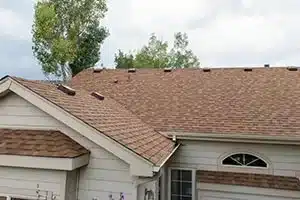
Shingles are the most popular roof material available today. Each shingle is relatively small at roughly 12″ tall and 36″ wide and less than 1/4″ thick. They are the most popular because they are the most affordable and the easiest to install and repair.
Metal
Metal roofing is most common in rural and mountain areas, although becoming more popular in urban areas, as well. Metal is the most durable roofing material available today. At your local home improvement stores, metal roof panels come in either 24″ or 36″ widths. Common stock lengths are 8′, 10′ and 12′. However, when we install metal roofs, we cut our own metal to order based upon the needs of the roof and homeowner. Those that choose metal panel roofs do so because they are somewhat easy to install, easily shed heavy snow and are low maintenance.
There’s also what’s called stone-coated metal shingles. These are 3’x1′ sheets of metal coated with the same granules as asphalt shingles. Metal shingles are more durable than traditional asphalt shingles, yet are easier to handle than long metal roofing panels.
Tile
Clay tile roofs have been around for hundreds of years. Fired clay tiles date to around 3,000 BCE. Roof tiles, whether made of clay or concrete, come in a variety of shapes. Each tile is hung from the framework of a roof. Because the tiles are made of clay or concrete, they are naturally resistant to fire. Due to their weight, they are resistant to high-winds.
Modified Bitumen
Modified bitumen is like tar that’s stuck to fiberglass fibers. It comes in rolls, which makes it easy to install. It is used only on flat or low slope roofs. It doesn’t last as long as other residential roofing systems, however it is among the least expensive, at around $4.25/sf., total, on average. Read more about modified bitumen roofing.
Slate
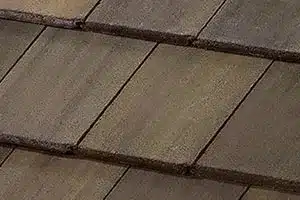
Slate is a natural, fine-grained rock composed of clay and volcanic ash. The standard roof slate tile vary in size from 6″ x 10″ to 14″ x 24″. Just like clay or concrete tile, each slate tile is hung from the roof framework with a nail. Because slate is a natural stone product, they are resistant to fire and environmentally friendly. Nevertheless, we do not offer slate roofing.
Wood Shake
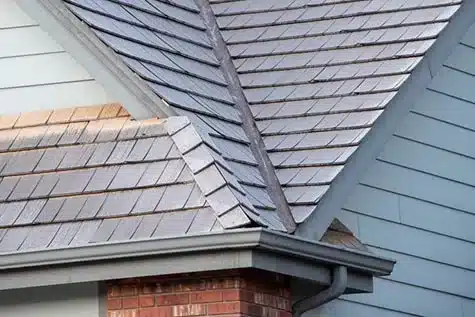
Traditionally, wood shake was made from split logs then formed to the desired shape. Wood shake is thin, usually 3/8″ to 3/4″ thick and 3″ to 8″ wide. Both wood shake and wood shingles are wedge-shaped. The difference between wood ‘shake’ and wood ‘shingles’ is; wood shingles are tapered. Because wood shake is a natural product, it is highly flammable, prone to mold and moss growth, doesn’t last long and is high maintenance. We do not offer wood shake.
So, Which Residential Roof is Best?
That depends upon a few factors. Even the so-called ‘best’ can have problems if it’s installed incorrectly. Also, the best roofing material, might not be the appropriate one for your roof’s pitch. How do you determine the right roofing material for your roof’s pitch?
Some might consider asphalt shingles the ‘best’ because they’re affordable, somewhat long-lasting, easy to install and repair, and versatile. Others might say metal panels are the best since they’re recyclable, long-lasting, and the ‘coolest’ steep slope roofing material.
Don’t Care About Cost?
If you don’t care about cost, get the longest-lasting. Clay or concrete tiles, and metal last the longest. A tile roof can last hundreds of years, if properly installed. Metal panels and shingles often last 70 years or more.
Get a Lot of Snow?
You might prefer a metal roof if you live in a region that gets a lot of snow due to metal’s ability to quickly shed a lot of heavy snow.
Money a Concern?
If money is the primary factor, asphalt shingles cost the least initially. If you can spend the extra dough upfront, metal panels, such as standing seam, will cost less in the long run, however.
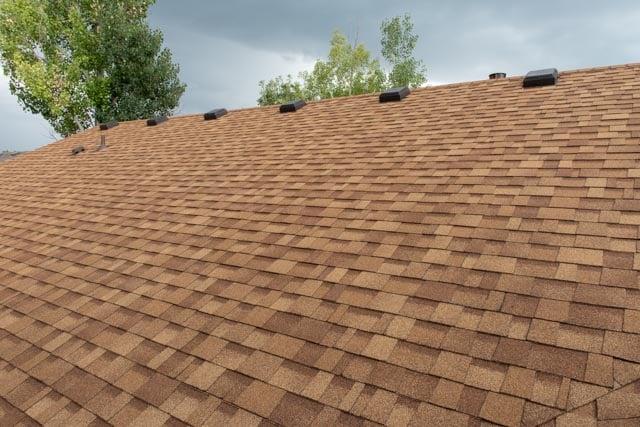
Asphalt Roofing Shingles
Asphalt roof shingles are a type of roof covering that uses asphalt for waterproofing. A shingle is thin and rectangular, measuring 12″ tall and 36″ wide and less than 1/4″ thick. The shingles overlap and seal to each other to cover a roof. Each shingle attaches to the roof deck with nails.
Read more about asphalt shingles.
The Life Expectancy of Shingles
The life expectancy of asphalt shingles vary. For instance, it depends upon the manufacturer and the installer, among other factors. However, your average asphalt shingle should last between 15 and 20 years. Higher-end shingles, such as Owens Corning’s TruDefinition Duration asphalt shingles, should last closer to 50 years.

Advantages of Asphalt Shingles
Asphalt shingles are the most affordable to install and repair. Compared to a metal roof, you’ll pay less than half for asphalt shingles. Compared to tile, you’ll pay around 33% less for mid-grade asphalt shingles.
The time to remove old asphalt shingles and install new ones on the average home is within 1 day. This assumes all new materials are on-site and no other roof work is required, such as roof deck repair.
Not all asphalt shingles are impact resistant. However, Owens Corning offers an impact-resistant option; TruDefinition Duration Storm.
Shingles are resistant to fire and algae. Furthermore, they are wind-resistant. For example, Owens Corning makes 60 and 130 mph wind-resistant shingles.
Asphalt shingles come in a wide variety of colors. For instance, Owens Corning’s Oakridge shingles come in 13 different colors.
Because asphalt shingles are thinner and flexible than tile or metal, you can cut them more easily and bend them to fit over peaks or into valleys.
Disadvantages of Asphalt Shingles
Compared to metal, tile and slate, asphalt shingles don’t last as long. At the most, asphalt shingles can last up to 50 years. On the other hand, a properly installed metal, tile or slate roof often last 70 years or more.
Although asphalt shingles are initially cheaper to install, given they don’t last as long as other roofing materials, they often end-up costing more over the long run.
Asphalt shingles are not recyclable in our Northern Colorado area.
Compared to clay tiles and standing seam metal panel roofing, asphalt shingles don’t help as much to lower your Summer cooling bill.
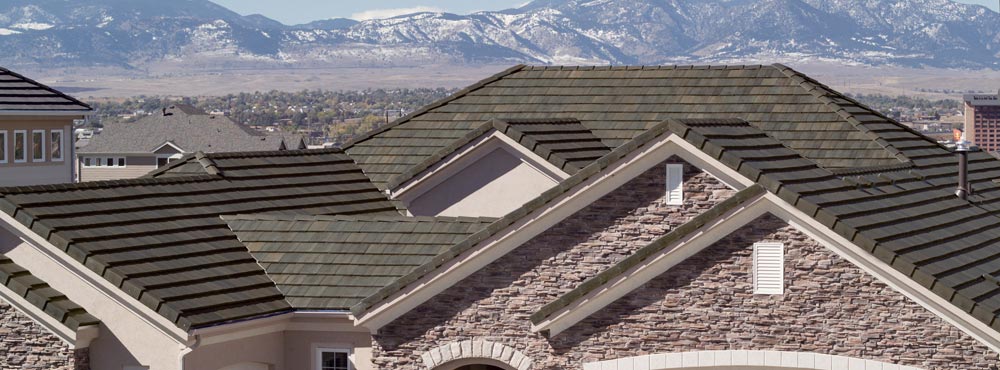
Tile Roofs
Manufacturing companies make tiles from natural, often local, materials such as clay or concrete. Nails secure the tiles to the roof framework. A tile roof is completed by starting at the bottom part of the roof then overlapping the next row of tiles over those. Tiles come in a small variety of shapes, colors, and sizes.
Life Expectancy of a Tile Roof
A tile roof can last hundreds of years if properly installed and it hasn’t been damaged. For example, it is rumored that in St. Augustine, Florida, there is still a working clay tile roof that dates to the 17th century. However, most of the time, a tile roof lasts between 50 and 75 years.
Advantages of a Tile Roof
Although roofing tiles are more expensive to install compared to other roofing materials, they often cost less over the long run. Tile roofing often lasts 70 years or more, which makes them one of the longest-lasting roofing materials. Clay and concrete are not combustible materials. Therefore, these tiles are fireproof. Tiles often weigh a lot more than asphalt shingles. This extra weight helps them resist high winds. There are a number of clay and concrete recycling centers in Northern Colorado, which makes tile roof a more ‘green’ roofing solution.
Disadvantages of a Tile Roof
Clay or concrete roofing tiles are initially more expensive to install and repair, compared to asphalt shingles and metal. Although clay and concrete tiles are durable, they are not indestructible. Tiles can break under the weight of the person installing them. Tiles are also heavy. Roofs that will have tiles installed onto them, often need additional structural reinforcement.
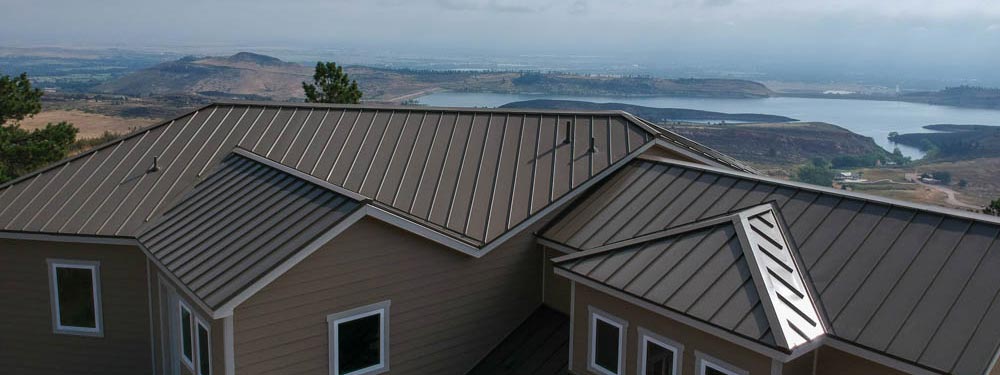
Metal Roofs
A metal roof is composed of sheets of metal (sheet metal) which are typically 24″ or 36″ wide and vary in length from 8′, 10′ or 12′. Each piece of sheet metal overlaps the previous sheet by 2″. Between the sheets is adhesive. Sheet metal screws with rubber washers are used where the sheets overlap to secure the sheets to the roof deck.
Life Expectancy of a Metal Roof
Depending upon the materials used, the life expectancy of a metal roof is between 40 and 70 years, if installed correctly and it is not damaged. However, if poor or thin materials are used, or the roof is damaged, the life expectancy is serious shorter.
Advantages of Metal Roofing
Metal roofing, such as standing seam, usually last at least 70 years. This is comparable to tile roofing, and at least twice as long as asphalt shingles. Because of this long lifespan, metal roofing often ends-up costing less than asphalt shingles in the long term. Most metal roofing, including metal shingles, are more durable than other roofing materials. Metal doesn’t burn, which is why metal roofing is more fire-resistant than asphalt shingles and wood shake. Because there are a number of metal recycling centers in our area, metal roofing is considered the more environmentally-friendly, or ‘green’ option.
Disadvantages of Metal Roofing
Metal roofing, be it metal shingles or standing seam, often cost two to three times as much as asphalt shingles, initially. If not properly insulated, a metal roof can be noisier than an asphalt shingle roof. Thinner metal roofing panels are prone to dents from large hail stones.
Modified Bitumen (ModBit) Roofing
ModBit is asphalt that’s been strengthened with rubber or plastic, and fiberglass fibers. It comes on a roll. The average life expectancy of ModBit is between 10-15 years. ModBit should not be installed onto steep-sloped roofs, and only onto roofs with a 3:12 or 14º pitch or less.
Advantages of ModBit Roofing
Modified bitumen is flexible and expands and contracts with the changing temperatures. It is the least expensive single-ply roofing material. As with asphalt shingles, it is somewhat resistant to tears and hail. ModBit comes as long rolls. Therefore, it is relatively easy to install. It’s repaired with simple patches. What’s more, thanks to the large sheets, it’s high wind resistant. As with asphalt shingles, ModBit is relatively low maintenance. A number of popular color options are available for ModBit, to compliment common asphalt shingle colors.
Disadvantages of ModBit Roofing
Modified bitumen has a short lifespan of only 10-15 years. It is also not recyclable in our Northern Colorado area.
How Much Does a New Roof Cost?
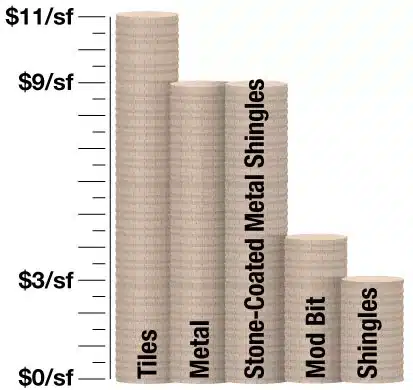
The cost to replace a roof depends upon a few factors, such as material used and square foot of the roof.
To replace asphalt shingles on a 2500 square foot roof with mid-grade asphalt shingles, expect to pay around $4.50/sf.
The same 2500 square foot roof with sheet metal will set you back $9.50/sf installed. Stone-coated metal shingles, expect around $12.50/sf to replace.
On that 2500 square foot roof, expect around $15/sf for clay tiles, $11/sf for concrete tiles.
Modified bitumen, plan on around $4.50/sf on that 2500 square foot roof.
What is the Average Roof Repair Cost?
The cost to repair a roof depends upon the material, type, and damage caused. Because asphalt shingles are the most common, let’s use that as the roof material and compare three types of damage:
- a 1″ diameter hole: $300
- chimney flashing damage: $750
- large tree branch damage: $1,500-$3,000
Life Expectancy of Popular Residential Roofs
Modified Bitumen: 10-15 years
Wood Shake: 15-25 years
Asphalt Shingles: 20-30 years
Metal: 40-70 years
Tile: 50-75 years
The Bottom Line
Thank you for visiting our Residential Roofing Guide. We hope you found it useful. Our primary intent is to share the common residential roofing materials, which you should choose, the life expectancy of each, the advantages and disadvantages of each, and average cost to install and repair.
The information here is based upon our own experience and research. We know the opinions of roofing contractors will vary. If you feel some information is incorrect or missing, please leave a comment below and let us know.

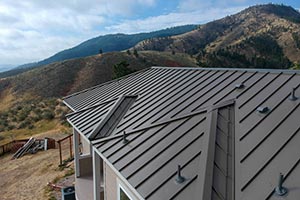

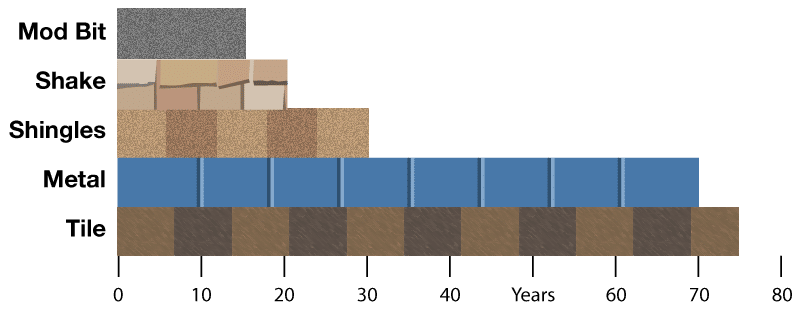
OMG! There’s so much great information on this page! This is quite a guide! The pros and cons, and costs, are really helpful! Thank you so much for all of this.
You’re welcome, Angie. Thank you for visiting our website and taking the time to read our content. Please let us know if we can answer any other questions of yours. Take care.